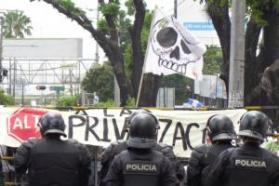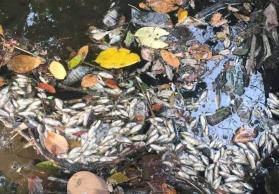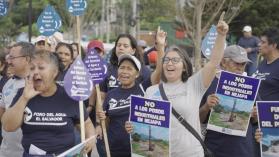Pacific Rim v. El Salvador and the Perils of Free Trade in the Americas
(from the Council on Hemispheric Affairs - includes quotes from CISPES)
by COHA Research Associate Krista Scheffey
In 2005, then-Senator Barack Obama published an opinion piece in the Chicago Tribuneentitled “Why I oppose CAFTA.” In his article, released on the samedate as the Senate vote on the Dominican Republic-Central American FreeTrade Agreement (“DR-CAFTA”), Obama explained that he would not votefor the bill and voiced his opinion that DR-CAFTA “…does little toaddress enforcement of basic environmental standards in the CentralAmerican countries and the Dominican Republic.”1Despite well-founded fears about the consequences of DR-CAFTA among itscritics, President George W. Bush and his administration lobbiedheavily for the passage of the bill, which was signed into law onAugust 2, 2005. El Salvador became the first of the Central Americannations to implement DR-CAFTA after the treaty took effect in thecountry on March 1, 2006.
Like the North American Free Trade Agreement (“NAFTA”), the treaty thatDR-CAFTA is based upon, DR-CAFTA’s Chapter 10 includes extensiveinvestor rights provisions. These clauses, ostensibly designed toencourage foreign investment, in fact allow multinational corporationsto avoid negotiations with individual governments and instead to settleinvestor disputes with an international tribunal. The first of suchcases adjudicated under DR-CAFTA began when Pacific Rim MiningCorporation (“Pacific Rim”*), a Vancouver-based gold explorationcompany, filed a petition calling for arbitration proceedings againstthe government of El Salvador for allegedly failing to grantexploitation permits in accordance with the mining laws of El Salvador.The corporation hopes to receive a compensatory payment totaling atleast US $77 million, the amount of money it claims to have lost whilewaiting for its mining permit to be issued. The case will have alarmingimplications in the event that the international tribunal rules infavor of Pacific Rim against the government of El Salvador: in additionto the staggering cost that would be imposed on the country, the casecould set a precedent for other private companies looking to settlecases in international venues that they presume would be moresympathetic to their cause.
Weighing the Pros and Cons: Mining and the Environment
The subject of the Pacific Rim case isthe El Dorado mine, located in the Cabañas department of El Salvador.As El Dorado is Pacific Rim’s “flagship” mining operation, the companyhas a huge stake in commencing the process of gold extraction. However,El Salvador’s Ministry of the Environment denied Pacific Rim anexploitation permit for the El Dorado mine after finding theEnvironmental Impact Assessment (“EIA”) unsatisfactory.2An outside report, conducted by independent hydrologist Robert Moran,confirms El Salvador’s analysis. Moran writes that “[the] EIA would notbe acceptable to regulatory agencies in most developed countries.”3He notes that, while Pacific Rim claims to have conformed to World BankGroup’s mining safety guidelines, “these guidelines are, in manyrespects, much weaker than those that would be required to operate amine in Canada or the U.S.A.”4
Operations in Cabañas began in 1993, when Mirage Resources and DaytonMining began exploration in the region; they found high-grade goldveins during the exploratory drilling phase. Pacific Rim had acquiredthe mine in 2002 through its merger with Dayton Mining.5According to Cameron Herrington, an organizer with the Committee inSolidarity with the People of El Salvador (“CISPES”), the community inCabañas became concerned with the possibly harmful environmental impactof the gold mine during the early phases of exploration.6Although the company only had carried out the exploratory drillingactivities at that stage, villagers had noticed that their wells weregoing dry. Access to water is a matter of grave concern in El Salvador,one of the countries with the least access to clean water in thehemisphere. According to Herrington:
When the people in Cabañas started to noticeenvironmental changes taking place because of the gold exploration,they did their research: they looked to places like Guatemala andHonduras, where mining has taken a huge toll. They learned aboutcommunities that had been devastated by water contamination from mining.
Cabañas is located on the Rio Lempa, amajor river in El Salvador and the country’s main source of freshwater. Gold processing requires a large input of cyanide, which PacificRim planned to detoxify through a decontamination process. However,Moran discovered that “[i]f [the EIA is] read closely, one will notethat no actual remediation measures are discussed for a spill ofcyanide into a river or lake – because all of the options havesignificant environmental impacts.”7 Already, 1.5 million people—nearly a quarter of the country’s population—lack access to clean water.8If gold processing chemicals contaminate the Rio Lempa, thousands ofSalvadorans will be directly affected. Water supply contamination wouldbe especially devastating for the people of Cabañas, who rely on theRio Lempa for all of their fresh water.
Even without a serious spill, the mine itself could jeopardize theavailable water supply in the region. Pacific Rim’s environmentalimpact assessment indicates that the plant would require 10.4 liters ofwater per second – over 3.2 million liters of water per year.9Herrington put this number into context, citing Salvadoran activists’analysis of Pacific Rim’s own studies, which found that “the amount ofwater the El Dorado mine would use per day to extract gold is what asingle Salvadoran family living near the mine would use for householdneeds in twenty years.” In a region where the majority of thepopulation relies on agriculture and fishing for survival, the ElDorado mine could cause a host of environmental problems. Furthermore,contamination of the Rio Lempa could destroy the community’s ability tosupport itself by farming and fishing, leading to economic ruin.
Long Term Damage, Short Term Gain
Another issue that the government of ElSalvador and the citizens of Cabañas must consider is the relativevalue of the gold mine over time. While water pollution andenvironmental contamination could threaten Cabañas and the Rio Lempafor years, Keith Slack, a Senior Policy Advisor and ExtractiveIndustries Campaign Manager at OxFam America, notes that:
The economic benefit of the mine to El Salvador wouldlikely be small, given that modern mining generates relatively fewjobs… It would provide income to the government, but past experienceshows that very little of those economic benefits would “trickle down”to the mining-impacted areas.10
While mining traditionally has played arole in the economies of Honduras and Guatemala, El Salvador has nothistorically had a large mining presence. As a result, mineralextraction has not been a major component of the country’s economy: in2006, mining represented only 0.4% of El Salvador’s GDP.11Furthermore, the El Dorado mine has a projected life of only 6.2 years,meaning that the anticipated economic gains would be relativelyshort-lived.12The CEO of Pacific Rim, Tom Shrake, estimates that the mine willproduce 2,000 jobs and generate income for the government, which wouldreceive 2-3% of the mine’s gross sales.13In reality, the number of jobs generated is likely to be significantlyless, and they would most likely be lost when the El Dorado mine isclosed.
In order to carry out mining in El Salvador, companies must first haveapproval to initiate exploration. After the exploration period, thecompany must apply for a mining permit by submitting an environmentalassessment survey and feasibility study.14Pacific Rim acquired exploration permits when it merged with DaytonMining in 2002. However, the government did not automatically approvethe company’s second application to begin actual exploitation of themine, citing Pacific Rim’s failure to provide an adequate feasibilitystudy—something that Pacific Rim denies.
Commentators have criticized El Salvador for failing to grant themining permit to Pacific Rim, suggesting that “gold, as an engine ofgrowth, has the potential to transform the country’s economy.”15However, Keith Slack, who has studied the history of resourceexploitation in Central America, predicts that the actual economictransformation would be far less monumental. He cites the San Martinmine that operated in Honduras from 2000-2007 and has been the basis ofinternational criticism due to the health problems it has spawned: “thelocal community experienced very little long-term economic developmentbenefit from the mine. Yet many community members allege thatcontamination from the mine has contributed to serious water pollutionand community health problems.” Without careful environmentalprotections in place, Cabañas could face the same dismal fate.
Getting Political
The initial exploration permit wasgranted to Mirage Resources in 1996, during the administration ofPresident Armando Calderón Sol. Calderón, of the right-wing Alianza Republicana Nacionalista (“ARENA”)party, won the presidency in 1994 in the first presidential electionsheld after the end of the Salvadoran Civil War. Calderón promotedneo-liberal economic programs during his presidency, hoping tostimulate investment—especially from newly resurgent foreigncompanies—after the country’s Civil War devastated its economy. PacificRim inherited the mining permits when it merged with Dayton mining;however, when it came time for Pacific Rim to reapply for exploitationpermits in 2006, then-President Antonio Saca, also of the ARENA party,was sufficiently wary of the mining company and refused to issue thepermits.16While Saca’s actions earned him criticism among more conservativecircles, his administration’s decision to stop the El Dorado miningproject was wildly popular amongst those who would be directly affectedby the project—the citizens of El Salvador, particularly those livingin Cabañas.
Unfortunately, the mining issue had become dangerously political andincreasingly violent approaching the 2009 Salvadoran presidentialelection. As Pacific Rim threatened to file international arbitrationproceedings using Chapter 10 of DR-CAFTA, a member of the ARENA partyproposed a new mining law with new regulatory standards. If approved,this effort may have led to the granting of new permits for the ElDorado mine.17These maneuverings put pressure on President Saca to privately settlethe case with Pacific Rim so as to avoid voter backlash; interestssupporting the Salvadoran mining project portrayed President Saca’sposition as one that created a hostile environment for internationalinvestment. Ultimately, President Saca did not cave in to the politicalpressure, and Pacific Rim officially filed suit against the governmenton April 30, 2009. In the historic elections that took place in ElSalvador on March 15, 2009, the Frente Farabundo Martí para la Liberación Nacional (“FMLN”)party candidate Mauricio Funes won with 51.3% of the vote. He hascontinued President Saca’s mining policies, refusing to grant PacificRim a license to begin exploitation of the El Dorado mine.
In addition to the political pressure exerted by the mining company,the issue of gold exploitation has also caused mounting instability andincreased violence in the Cabañas region. To date, three prominentanti-mining activists have been killed in Cabañas: the tortured body ofactivist Marcelo Rivera was found in a community well in June 2009, andRamiro Rivera Gomez and Dora “Alicia” Recinos Sorto—both outspokencritics of the gold mine—were murdered in December. According toHerrington, “there is no evidence to link these murders back to themining company. However, the wave of violence in Cabañas is clearly aresult of Pacific Rim’s presence in the region. The tortured body of aprominent anti-mining activist found in the bottom of a well isobviously trying to send a political message.” Despite community andgovernment opposition to the mining project, Pacific Rim remains apresence in Cabañas, exerting political pressure while outbreaks ofviolence continue to take place.
The El Dorado mine has never been operational—and therefore has notbeen profitable—since President Saca refused to stand down on hismining position and did not issue the company the necessaryexploitation permits. In 2008, Pacific Rim made serious cutbacks to theEl Dorado project, and “does not intend to resume significantexploration work at the El Dorado project until such time as theenvironmental permit is received and the exploitation concession isgranted.”18But, in reality, Pacific Rim now hopes to circumvent the Salvadorangovernment’s decision altogether by following a strategy of appealingdirectly to an international tribunal using the extensive investorrights provisions of DR-CAFTA.
DR-CAFTA’s Troublesome Record
DR-CAFTA’s potential to cause, ratherthan to solve, environmental and labor problems was already feared atthe time the treaty was being negotiated. NAFTA, the precursor toDR-CAFTA, had been shown to create a “race to the bottom” in regard towages and regulatory standards, causing major job loss in the UnitedStates as well as dangerous working conditions in Mexico. Despite theseconcerns, President George W. Bush made passing the Central Americanfree trade agreement a matter of the highest priority during hispresidency, much like President Clinton before him had done with NAFTA.Congress voted to grant President Bush “fast-track” trade promotionauthority with the Trade Act of 2002, which gave the presidentsubstantial power to negotiate trade legislation with limitedCongressional oversight. According to the Council on Foreign Relations,“[trade promotion authority] is seen as a critical tool forfacilitating trade liberalization by streamlining the complicatedprocess of drawing up trade legislation.”19When the president has fast-track authority, neither body of Congresscan modify the bill, but can only vote for or against the measure.Trade Promotion Authority has been used by a number of presidents inthe past, including President Clinton when he negotiated the UruguayRound Agreement in 1994.
DR-CAFTA was signed into law in the United States on August 2, 2005,only a few years after the initial negotiations had begun. Thisrepresents a very short period of time to negotiate an internationaltrade treaty. One reason the discussions were so brief is the fact thatDR-CAFTA borrows much of its language from the text of NAFTA. Criticscontend that the shared language replicates NAFTA’s lack ofenvironmental and labor protections. Both neo-liberal trade agreementshave the potential to transfer decision-making power away from nationalgovernments to multinational corporations.
Before DR-CAFTA was approved, The Economic Policy Institute published areport warning of the dangers of adopting another NAFTA-style freetrade agreement. In their piece, authors David Ratner and Robert E.Scott write:
NAFTA is a free trade and investment agreement thatprovided investors with a unique set of guarantees designed tostimulate foreign direct investment and the movement of factorieswithin the hemisphere, especially from the United States to Canada andMexico. No protections were contained in the core of the agreement tomaintain labor or environmental standards. As a result, NAFTA tiltedthe economic playing field in favor of investors and against workersand the environment, causing a hemispheric “race to the bottom” inwages and environmental quality.20
These same investor rights protectionsare repeated in DR-CAFTA’s Chapter 10, provisions that may have beenamended if Congress and members of civil society had ample time tovoice their opinions on DR-CAFTA before it became law.
International Interests with A Powerful Voice in Cabañas
Pacific Rim Mining Corp. operates the El Dorado mine through theirwholly-owned subsidiary Pac Rim Cayman, LLC (“Pac Rim”), based inNevada. The El Dorado project, located about an hour outside of SanSalvador, is Pacific Rim’s “flagship exploration asset and has receivedthe bulk of the Company’s exploration efforts over the past 7 years,”according to the company’s website.21
Canada is not a signatory of DR-CAFTA, and thus Vancouver-based PacificRim is filing the suit through its Nevada subsidiary, Pac Rim. Until2007, the Pac Rim subsidiary was located in the Cayman Islands; thecompany has come under criticism for moving the branch with the soleintention of being eligible to file suit under DR-CAFTA. Under thetreaty, investment disputes must be settled in an internationaltribunal. The International Center for Disputes (ICSID), an institutionof the World Bank Group located in Washington, DC, is often the finaldestination for international resource cases.
The Pacific Rim case is not the first international resource dispute tobe resolved in the ICSID. The number of cases filed has gone updramatically over the past ten years. According to a report by theInstitute for Policy Studies (IPS), there are currently 32 pendingcases related to oil, mining, and gas in the ICSID, whereas “ten yearsago, there were only three pending ICSID cases” of the same nature.22Countries in Latin America are disproportionally involved in casesinvolving oil, mining, and gas: IPS estimates that 66% of the casesfiled globally are lodged against countries in Latin America.
The basis of Pacific Rim’s case involves DR-CAFTA’s investor rightsprovision, which stipulates that “each Party shall accord to investorsof another Party treatment no less favorable than that it accords, inlike circumstances, to its own investors.”23Pacific Rim alleges that the government of El Salvador has failed touphold its own laws by not granting the second round of miningconcessions. The ICSID must decide if El Salvador violated Chapter 10of DR-CAFTA by treating Pacific Rim differently than it would treat aSalvadoran mining company.
Dangerous Precedent
The international tribunal’s decision on the Pacific Rim v. El Salvadorcase is likely to have reverberations around the world. Should thetribunal rule in favor of Pacific Rim, it will signal to otherinternational corporations that they, too, will find a sympathetic earin Washington. It will also set a precedent for the numerous lawsuitsthat already have been filed with ICSID pertaining to resourceexploitation in Latin America. The Pacific Rim case has the potentialto replicate itself, as Canadian mining companies overwhelmingly chooseLatin America as the site of their mining investments.24 Within Canada, there is very little regulation of mining companies’ impact abroad.25If DR-CAFTA is interpreted to favor foreign mining interests oversovereign governments, there will be little recourse to preventcontinued environmental exploitation by foreign mining companiesoperating in Latin America.
*For clarity, I refer to the mining company as “Pacific Rim”throughout my analysis. Legally, the El Salvador mine is operated bythe Nevada-based subsidiary “Pac Rim”
References for this memorandum may be found here.

 "I am a CISPES supporter because continuing to fight for social justice and a more people-centered country means continuing the dream and sacrifice of thousands of my fellow Salvadorans who died for that vision.” - Padre Carlos, New York City
"I am a CISPES supporter because continuing to fight for social justice and a more people-centered country means continuing the dream and sacrifice of thousands of my fellow Salvadorans who died for that vision.” - Padre Carlos, New York City

